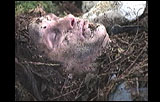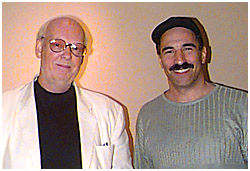The X-Files
Australian Conne-X-ion
The Crew
Effects and Sound:
Toby Lindala, Special Effects Make-up

Toby Lindala was working on the pilot episode of The X-Files, trying to make a good impression, and Chris Carter was anxious about getting the girl's nose to bleed just right. "You can't just put something in and wait for it to explode," recalls Carter. "You've got to pipe in a good supply of blood and have it look spontaneous. When I first saw the test, I thought we were doomed." But it turned out to be a most convincing blood letting, "and Toby has become one of the stars behind the camera."
A young, bearded man with long flowing hair and an unassuming manner, Lindala felt the calling at a young age. He began scaring people with latex and blood when he was around ten years old, and used to creep downstairs at 2 a.m. to pick up techniques from old horror movies.
Another memorable triumph was getting those worms to wriggle so revoltingly under the skin of the dog and two people in "Ice." His first model, a gelatin-based prosthetic, kept tearing, and time was running out. So Lindala created casts of the actor's necks and created a channel with monofilaments attached to a row of beads that could move and contract on command.
While Lindala has created some of the most outrageous effects on television--spurting boils, salamander hands, bile-like slime, alien corpses and fetuses, spikes bursting out of throats (aided by unlubricated Sheik condoms), and the entire Flukeman costume (built in only ten days)--subtlety is his mantra. "The make-up should never eclipse the story by drawing undue attention to itself. And it will only work if the plot and characters are strong and compelling."
John Bartley, Director of Photography

John Bartley loves surprises. And that's a good thing. As if shooting The X-Files weren't challenging enough, what with morphs, mutants, and other monsters to work around, some of the scripts are received only days in advance. Much of the action is shot on location. And the capricious Vancouver weather--grey and rainy one moment, bright and sunny the next--makes matching the shots an ongoing challenge.
To Bartley, as to most critics and viewers, The X-Files has more in common with cinema than with anything currently on television. "Every episode is like a mini-movie, with the difference that you only get eight days to shoot it," says Bartley, who shoots with an Arriflex 35mm camera, on 5293 and 5298 film stock.
Involved in theatre and television in his native Australia, Bartley worked as a gaffer on many commercials and music videos after moving to Canada. He met future X-Files writers and producers Glen Morgan and James Wong while working as DP on "The Commish," and they remembered the quality of his work. Bartley quickly garnered recognition from critics and peers for the richly textured, almost film noiresque lighting that so compliments the show's subtext of ambiguity and lurking dread.
Bartley was recently nominated by the American Society of Cinematographers for the Outstanding Achievement Award for Episodic Television for "Duane Barry" episode, which he considers one of his greatest challenges. There were all this little aliens that needed to be seen, but not too clearly. So Bartley overexposed the film and used strobes to blow it all out.
One of his most enthusiastic fans is Chris Carter. "Bartley's a secret weapon; he gives the show the cinematic look that we're seeking, and he really helps us to scare you by half lighting things and hiding them in shadow."
Another, more terrestrial challenge is trying to frame two stars who stand nearly a foot apart in height. Solution? The "Gillian Board" and high heels.
Mat Beck, Visual Effects Supervisor

After creating special effects for The X-Files, computer graphics whiz Mat Beck may have one of the weirder resumes going. It includes everything from adding a trickle of blood to Mulder's neck to morphing an alien's gender, stretching a mutant's limbs, and creating UFOs too numerous to count. Not to mention hordes of little green bugs and fanning a few flames into an inferno.
 Because virtually all of the special effects on The X-Files are computer generated--not built--Beck is rarely too far from his Macintosh PowerBook, where he maps out his ideas before passing them on to computer production houses.
Because virtually all of the special effects on The X-Files are computer generated--not built--Beck is rarely too far from his Macintosh PowerBook, where he maps out his ideas before passing them on to computer production houses.
On the pilot episode, he impressed Chris Carter by creating the critical whirling vortex of leaves, and got himself a job offer. "His high taste level is one of the reasons The X-Files is such a beautiful show," confirms Carter. "His effects are believable, minimal, never overblown."
There is little that Beck can't do with a computer. Ironically, the better he does his job, the more innocuous it looks. His creations never scream out "special effect!" Instead, they help to support the ambiguous, ever-questioning subtext of the show. For example, a Beck spaceship might be a UFO...then again it could just be a helicopter...
An image that is too slick can also work against the end result. For example, when morphing one object to another, Beck finds it can be more effective and interesting to slow things down and allow a slight mismatch.
Some of his effects are hybrids of the physical and the digital. To create Samantha's reflection in the window during her abduction in "Little Green Men," Beck took an exterior image created during shooting, flopped it, and placed it faintly into the window space--working around a real shaft of light that was coming into the room.
All in a day's work. After all, as he is fond of saying, "Magic is simply technology where people don't know how it works."
Mark Snow, Composer
The Julliard-trained composer who once aspired to play oboe with a symphony orchestra, now sits in a converted garage before his Synclavier-repository of sampled sounds from the eery to the ethereal-and Macintosh computer.
Veteran of a group called The New York Rock and Roll Ensemble, Mark Snow moved to Los Angeles and began scoring for television movies before joining up with The X-Files. From the first episode, he managed to capture the show's moody tone and translated it to music--an achievement comparable to Angelo Badalamenti's scores for Twin Peaks.
Compared to most hour-long shows, which have 10-15 minutes of music, every episode of The X-Files has about 30-35 minutes of music, which takes Snow five or six days to score. He works closely with Chris Carter, who has very specific musical tastes, as well as Paul Rabwin, the producer in charge of post production, to marry the music to the sound effects in a way that is virtually seamless.
Ideal mirrors for the stories they accompany, his compositions are rich, neutral, and notable for their restraint. Before Snow wrote the haunting, whistled, almost-terse title theme, Carter sent him everything from John Adams and Philip Glass to rock and roll for inspiration. After several iterations, Snow decided to go completely off the wall-and that's the version that nailed it for Carter.
You can read a long Mark Snow article on my News Stand section, titled The Ambience Is Out There.
Back to The X-Files Crew Main Page.



 Because virtually all of the special effects on The X-Files are computer generated--not built--Beck is rarely too far from his Macintosh PowerBook, where he maps out his ideas before passing them on to computer production houses.
Because virtually all of the special effects on The X-Files are computer generated--not built--Beck is rarely too far from his Macintosh PowerBook, where he maps out his ideas before passing them on to computer production houses.